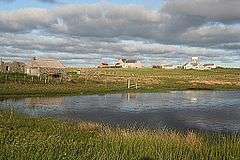Swainbost
Swainbost (Scottish Gaelic: Suaineabost) is a village on the Isle of Lewis in the district of Ness, in the Outer Hebrides, Scotland. The name Swainbost meaning Sweins steading is of Viking derivation.[1] The settlement is situated in the parish of Barvas.[2] The remains of the church of Saint Peter, Teampull Pheadair, are located north of the settlement.[3] The building was the parish church of Ness, and became a ruin in 1829.[3]
Swainbost
| |
|---|---|
 An unnamed lochan at Swainbost | |
 Swainbost Location within the Outer Hebrides | |
| Language | Scottish Gaelic English |
| OS grid reference | NB511625 |
| Civil parish | |
| Council area |
|
| Lieutenancy area | |
| Country | Scotland |
| Sovereign state | United Kingdom |
| Post town | ISLE OF LEWIS |
| Postcode district | HS2 |
| Dialling code | 01851 |
| Police | Scotland |
| Fire | Scottish |
| Ambulance | Scottish |
| UK Parliament | |
| Scottish Parliament | |
According to Ronald Black, Swainbost was re-settled during the Highland Clearances in 1842. The island's Anglo-Scottish landlord had expected the crofters evicted from Uig to emigrate and only reluctantly granted them land at Swainbost to avert the threat of violence.[4]
At the shore, there is a large depression called Suaineabost Sands which displays glacier activities and is run through by a river.
People
- Aonghas Caimbeul, alias Am Puilean (1903-1982), Scottish Gaelic Bard, war poet, and award-winning memoirist.[5]
References
- "Swainbost". PBWorks. Retrieved 18 December 2014.
- "Lewis, Swainbost". Royal Commission on the Ancient and Historical Monuments of Scotland. Retrieved 18 December 2014.
- "Lewis, Ness, Teampull Pheadair". Royal Commission on the Ancient and Historical Monuments of Scotland. Retrieved 18 December 2014.
- Ronald Black (1998), An Tuil: Anthology of 20th Century Scottish Gaelic Verse, page 757.
- Ronald Black (1998), An Tuil: Anthology of 20th Century Scottish Gaelic Verse, pages 757-758.
External links
| Wikimedia Commons has media related to Swainbost. |